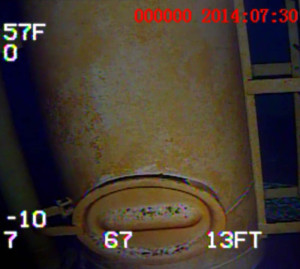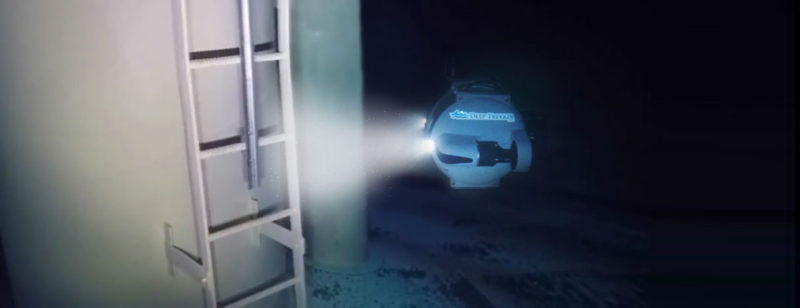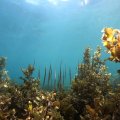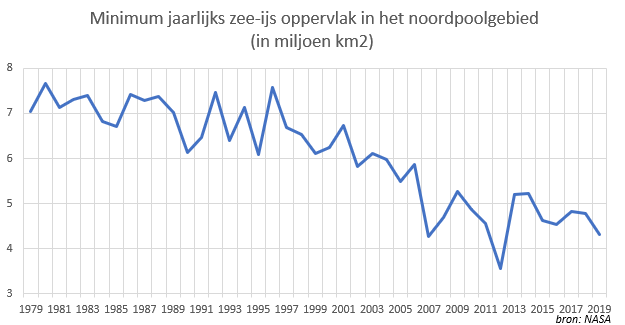The importance of a clean drone is crucial!
To maintain optimal water quality, a regular tank inspection and cleaning is a necessity. Unfortunately, traditional tank operations can come with numerous costs and problems, such as hiring divers, draining tanks and suspending service.Om de waterkwaliteit optimaal te houden, zijn regelmatige tankinspecties en -reinigingen een noodzaak. Helaas kunnen de traditionele tankbewerkingen gepaard gaan met tal van kosten en problemen, zoals het inhuren van duikers, het aftappen van tanks en het opschorten van de service.
Deep Trekker‘s underwater drones allow users to perform precise inspections from above – without draining tanks or taking them out of service. In addition, the use of robots keeps divers away from unnecessary risks and complications.
By using the ROV camera’s live video feed, pilots can complete the inspection while recording everything the ROV sees. Simultaneously, photos or videos can be taken and voice notes can be recorded with the video for archiving and review purposes. With Deep Trekker, consistent and accurate inspections can be performed with a minimum of time and financial interference. Impact on drinking water and nature is therefore paramount, and keeping a drone clean is easier than a human!
The DT640 VAC allows users to clean a tank floor. The suction head allows operators to effectively clean sediment and sludge through a pump and hose attached to the suction head. allows users to clean a tank floor. The suction head allows operators to effectively clean sediment and sludge through a pump and hose attached to the suction head.
The convenience of an underwater drone!
One of the biggest risks of putting divers in tanks is the risk of contamination from their equipment or personal bacteria if they don’t follow a strict procedure. There are many “corners” on a wetsuit that can contain bacteria and other potentially harmful substances for drinking water.
“It’s nice to save my divers from unnecessary climbing or entering a tank that was in good condition,” adds Jake Spaulding of Mountain West Commercial Diving, “It’s so much more fun to take the ROV to the top of a tower than to send a diver with equipment up a ladder of 22 meters. Now we only send divers if we know that it is necessary.”
Due to their ease of use, portability and ability to be thoroughly cleaned and disinfected, Deep Trekker underwater robots are ideal for inspecting and cleaning drinking water tanks, among other things. When working on drinking water tanks, there are specific procedures that must be followed to ensure the cleanliness and safety of the water. Not sure what a good procedure is for drinking water tanks or pipes? We’ve outlined the main steps for cleaning an ROV used by industry professionals below.
1.CHECK THAT THE EQUIPMENT IS INTENDED FOR DRINKING WATER USE ONLY.
It is imperative that the ROV and related equipment be used only for drinking water. Find a process that works for you and your company to control which vehicles are used exclusively for drinking water. It may also be helpful to have a system to track where and when each vehicle has been used to serve as further confirmation. Therefore, never use drones unnecessarily for different purposes, cleaning never gives 100% exclusion!
2. OBTAINING NEW (UNUSED) PLASTIC SHEETS.
Plastic sheets are necessary for thorough cleaning of the vehicle. The use of plastic sheets prevents the vehicle and associated equipment from being placed on the ground, and therefore, remains clean. Although these plates are disinfectible, it is important that these plastic plates are unused to further verify cleanliness.
The vehicle and cable, as well as any cords, ropes or additional equipment, will later be spread out on these plates for cleaning
3.OBTAINING A DISINFECTANT SOLUTION.
Disinfectant is essential for properly cleaning and keeping the drone clean. There are several guidelines that this must meet, and this can vary from authority to authority. A chlorine solution is often the most commonly chosen solution, and also recommended by us.
4. DISINFECT PLASTIC SHEETS USING THE DISINFECTANT SOLUTION..
By using an approved disinfectant solution, the plastic sheets should be thoroughly cleaned. Unused disposable protective gloves and clothing are required during this procedure to protect the personnel involved.
5. VEHICLE AND CABLE ARE PLACED ON A CLEAN AND DISINFECTED GROUND SHEET AND SPRAYED WITH DISINFECTANT.
Place the vehicle and cable on a clean and disinfected ground sheet. Spray the material thoroughly with the disinfectant.
All plastic ropes and cables, used for example to hoist a vehicle, are treated in the same way. All disinfected cords, cables and equipment are placed on clean, disinfected ground sheets while other parts are treated.
**Attention: these procedures are guidelines only and do not follow official regulations. Regulations vary somewhat from region to region, so it is important to consult with your local authorities about best practices. We provide you with guidelines here, which can be taken into account.
From inspection to action!
Effective inspection and cleaning is critical to good water maintenance. In water storage tanks, water sits virtually still. Over time, sediment sinks to the bottom. Even your drinking water has some particles and minerals in it. Small amounts of sediment do not affect the quality of the water or the health of those who drink it, it also has almost no impact on the structural integrity of the storage tank.
But as this sediment builds up over time and mixes into thicker sludge material, it can affect the quality of the water and the structure of the tank. Every tank manufacturer recommends regular inspection of the water tower and subsequent cleaning of the tanks to ensure long-term integrity.
With a robot, such as the DT640, you can perform tank cleaning efficiently and at regular intervals to prevent sediment or sludge from accumulating over time. The low cost of the vehicle makes it realistic to have an ongoing water storage tank maintenance program, either as a service provider or as the municipality itself.
Benefits of a ROV
Without an ROV, the inspection and cleaning of water tanks is usually performed by commercial divers. This involves using a team of divers and spotters to enter the confined space. This can be both risky and expensive.
In addition, placing a human diver in drinking water is not the most sanitary option. It is difficult and expensive to sanitize an entire diving suit, which may also have been used in non-potable water applications before entering the tank.
Options that apply to drinking water tanks often also apply to protected natural areas. Here, of course, no negative effects may appear on aquaculture. By cleaning and maintaining an underwater drone, these negative effects do not apply, and inspections can be done safely and easily. This gives unique opportunities because not everyone is allowed to inspect in protected areas without proof that there are no negative side effects.

Even under a layer of ice, our drones are ‘just’ usable. It is easy and you are spared most of the cold! In these areas where humans hardly ever visit, it is important that the impact is brought to a minimum.
Would you like to know more about the possibilities of drone cleaning? Or would you like to know what resources we use, or how we deploy the drone in “clean” areas? Then get in touch via Facebook of LinkedIn!










 (Image from KNMI*, made by NASA) This is a graph about the total ice surface found on the sea.
(Image from KNMI*, made by NASA) This is a graph about the total ice surface found on the sea.

 (Photo from
(Photo from 










